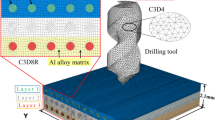Abstract
Temperature distribution of plain-woven aramid fiber-reinforced plastics (AFRP) composites was investigated by numerical and experimental methods for their drilling process with low-mild spindle velocities. A three-dimensional (3-D) numerical model was proposed for predicting the temperature distribution. Drilling experiments were carried out to verify the proposed numerical model and investigate the thermal damages with low-mild spindle velocities. The accuracy of the proposed numerical model was acceptable with less than 8% relative errors compared with experimental results. Cutting heat easily accumulated even the AFRP composites were drilled with low-mild spindle velocities for their poor thermal conductivity. Temperature distributions presented a rounded diamond shape, which diagonal direction was consistent with the fiber direction. With the high heat accumulation, although the drilled hole wall was damaged by the high temperature, carbonation phenomenon was not serious for the low spindle velocity drilling. For the mild spindle velocity drilling case, a serious carbonation phenomenon had been observed, and the heat-affected layer in the hole wall was about 0.3 mm.
Similar content being viewed by others
References
Karpat Y, Degerb B, Bahtiyar O (2012) Drilling thick fabric woven CFRP laminates with double point angle drills. J Mater Process Technol 212:2117–2127
Persson E, Eriksson I, Zackrisson L (1997) Effects of hole machining defects on strength and fatigue life of composite laminates. Compos Part A 28A:141–151
Won MS, Dharan CKH (2002) Drilling of aramid and carbon fiber polymer composites. J Manuf Sci Eng 124:778–783
Sorrentino L, Turchetta S, Colella L, Bellini C (2016) Analysis of thermal damage in FRP drilling. Process Eng 167:206–215
Chatterjee A (2009) Thermal degradation analysis of thermoset resins. J Appl Polym Sci 114:1417–1425
Zhu DJ, Zhang XT, Zhang HA (2016) Effects of strain rate and temperature on mechanical properties of Kevlar 49 aramid fabric reinforced epoxy polymers under dynamic tensile loading. Acta Materiae Compositae Sinica 33:459–468
Bhattacharyya D, Horrigan DPW (1998) A study of hole drilling in Kevlar composites. Compos Sci Technol 58:267–283
Gao H, Zhuang Y, Wang B, Huang JL (2012) Study on the combined machining technology of sawing and grinding for drilling aramid/epoxy composites. Adv Mater Res 565:436–441
Shuaib AN, Al-Sulaiman FA, Hamid F (2004) Machinability of Kevlar 49 composite laminates while using standard TiN coated HSS drills. Mach Sci Technol 8:449–467
Zheng L, Zhou H, Gao C, Yuan JT (2012) Hole drilling in ceramics/Kevlar fiber reinforced plastics double-plate composite armor using diamond core drill. Mater Des 40:461–466
El-Taweel TA, Abdel-Maaboud AM, Azzam BS, Mohammad AE (2009) Parametric studies on the CO2 laser cutting of Kevlar-49 composite. Int J Adv Manuf Technol 40:907–917
Wang FB, Wang YQ, Hou B, Zhang JB, Li YP (2016) Effect of cryogenic conditions on the milling performance of aramid fiber. Int J Adv Manuf Technol 83:429–439
Sorrentino L, Turchetta S, Bellini C (2017) In process monitoring of cutting temperature during the drilling of FRP laminate. Comp Struct 168:49–561
Yilbas BS, Akhta SS (2012) Laser cutting of Kevlar laminates and thermal stress formed at cutting sections. Opt Laser Eng 50:204–209
Bao YJ, Zhang YN, Gao H, Liu XS (2015) Temperature field study of hole drilling in Kevlar composites. Adv Mater Res 1136:215–220
Sadek A, Shi B, Meshreki M, Duquesne J, Attia MH (2015) Prediction and control of drilling-induced damage in fibre-reinforced polymers using a new hybrid force and temperature modelling approach. CIRP Ann Manuf Technol 64:89–92
Tsao CC, Hocheng H (2008) Evaluation of thrust force and surface roughness in drilling composite material using Taguchi analysis and neural network. J Mater Process Technol 203:342–348
Ciriscioli PR, Springer GS, Wang Q (1991) A technique for determining mechanical properties of thick composite laminates. J Compos Mater 25:1330–1339
Korab J, Stefanik P, Kavecky S, Sebo P, Korb G (2002) Thermal conductivity of unidirectional copper matrix carbon fibre composites. Compos Part A: Appl Sci Manuf 33:577–581
Bono M, Ni J (2002) A model for predicting the heat flow into the workpiece in dry drilling. J Manuf Sci Eng 124:773–777
Weinert K, Kempmann C (2004) Cutting temperatures and their effects on the machining behaviour in drilling reinforced plastic composites. Adv Eng Mater 6:684–689
Cui Y, Li H, Li T, Chen L (2018) An accurate thermal performance modeling and simulation method for motorized spindle of machine tool based on thermal contact resistance analysis. Int J Adv Manuf Technol 96:2525–2537
Su F, Yuan J, Sun F, Wang Z, Deng Z (2018) Modeling and simulation of milling forces in milling plain woven carbon fiber-reinforced plastics. Int J Adv Manuf Technol 95:4141–4152
Kundakcıoğlu E, Lazoglu I, Poyraz Ö, Yasa E, Cizicioğlu N (2018) Thermal and molten pool model in selective laser melting process of Inconel 625. Int J Adv Manuf Technol 95:3977–3984
Islam C, Lazoglu I, Altinta Y (2016) A three-dimensional transient thermal model for machining. J Manuf Sci Eng 138:021003-1–021003-17
Zhu GP, Bao YJ, Gao H (2012) Research on the drilling temperature field model of the unidirectional carbon fiber epoxy composites. Adv Mater Res 565:478–483
Hocheng H, Tsao CC (2003) Comprehensive analysis of delamination in drilling of composite materials with various drill bits. J Mater Process Technol 140:335–339
Funding
This research was supported by the National Natural Science Foundation of China (NSFC) [grant numbers 51475073, 51375068, 51605076]; the National Key Basic Research Program of China (973 Project) [grant number 2014CB046504]; and the Fundamental Research Funds for the Central Universities [grant number DUT16QY01].
Author information
Authors and Affiliations
Corresponding author
Rights and permissions
About this article
Cite this article
Bao, YJ., Hao, W., Gao, H. et al. Numerical and experimental investigations on temperature distribution of plain-woven aramid fiber-reinforced plastics composites with low-mild spindle velocities. Int J Adv Manuf Technol 99, 613–622 (2018). https://doi.org/10.1007/s00170-018-2424-9
Received:
Accepted:
Published:
Issue Date:
DOI: https://doi.org/10.1007/s00170-018-2424-9




